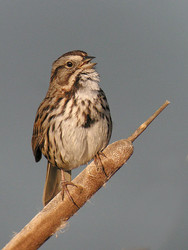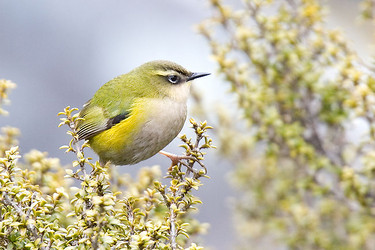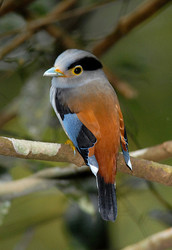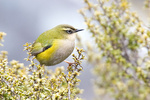Passeriformes
Perching Birds, Passerine Birds
Scott V. Edwards and John Harshman


This tree diagram shows the relationships between several groups of organisms.
The root of the current tree connects the organisms featured in this tree to their containing group and the rest of the Tree of Life. The basal branching point in the tree represents the ancestor of the other groups in the tree. This ancestor diversified over time into several descendent subgroups, which are represented as internal nodes and terminal taxa to the right.

You can click on the root to travel down the Tree of Life all the way to the root of all Life, and you can click on the names of descendent subgroups to travel up the Tree of Life all the way to individual species.
For more information on ToL tree formatting, please see Interpreting the Tree or Classification. To learn more about phylogenetic trees, please visit our Phylogenetic Biology pages.
close boxIntroduction
The Passeriformes is the largest and most diverse commonly recognized clade of birds. The Passeriformes (or ‘passerine’ birds) are synonymous with what are commonly known as "perching birds"; this group also contains within it a major radiation commonly known as songbirds (oscine Passerines or Passeri). Of the 10,000 or so extant species of birds, over half (~5,300) are perching birds.
Perching birds have a worldwide distribution, with representatives on all continents except Antarctica, and reaching their greatest diversity in the tropics. Body sizes of passerines vary from about 1.4 kg in northern populations of Ravens (Corvus corax) to just a few grams. Perching birds include some of the most colorful and mysterious of all birds, such as birds of paradise from New Guinea and the bright orange Cock of the Rock from tropical South America. Because of their high diversity, generally small body size and relative ease of observation, collection and field study, perching birds have historically attracted the attention of a wide range of descriptive and experimental biologists, including systematists, behavioral ecologists, and evolutionary biologists.
Monophyly and Sister Group
Historically, it is generally agreed that the Passeriformes constitute a monophyletic group. Raikow (1982) established this monophyly in an explicitly phylogenetic context. He noted that Passeriformes possess a suite of distinguishing characteristics, including a unique sperm morphology, a distinctive morphology of the bony palate, a simple yet functionally diverse foot with three toes forward and one (the hallux) oriented backwards, and a distinctive fore- (wing) and hindlimb musculature. There are few if any species which pose problems for avian systematists as to whether they are or are not passerines. Most of the controversy lies in relationships within the clade.
The sister group of the Passeriformes is not so much hotly contested as it is poorly resolved by existing data sets. Traditionally, Passeriformes have been considered closely related to a large group known as the “higher non-Passerines”. These include a number of clades such as cuckoos (Cuculiformes), hornbills, kingfishers and related lineages (Coraciiformes), and woodpeckers and relatives (Piciformes). Many of these groups possess a zygodactyl foot, a condition in which two toes point forward and two point backward. The sister relationship of Passeriformes to woodpeckers, the hornbill group and allies is reflected in Joel Cracraft’s phylogenetic hypothesis for major groups of birds based on cladistic interpretation of morphological and molecular characters (Cracraft, 1988). However, in the other major classification bearing on the relationships of perching birds, that based on DNA-DNA hybridization, Passeriformes appear as the sister group to a large, diverse group containing pigeons and doves (Columbiformes), cranes and rails (Gruiformes) and storks (Ciconiiformes)! These latter three groups share few obvious morphological characteristics with Passeriformes. However, the DNA hybridization tree links Passeriformes with these groups at a very deep level in the tree, rendering this result tenuous. A recent study of nuclear DNA sequences by Hackett et al. (2008) finds Psittaciformes (parrots) to be the sister group of passerines, with Falconidae (falcons) also close. Clearly, more work on the sister-group relationship of Passeriformes is needed, since this relationship will be the basis of any study seeking to identify whether or not Passeriformes are a particularly diverse group (e.g., Nee et al. 1992).
Major Groups of Passeriformes
The basal lineages of passeriformes have for over a century included two major clades, the oscines and suboscines. Suboscines (sometimes called Tyranni, though this name has confusingly been used also for more restrictive groups within Suboscines) are a largely tropical group of about 1,000 species that reaches its greatest diversity in South America; most suboscines are thought to sing “innate” songs. Oscines (Passeri) include about 4,000 species and are what many laypersons refer to as “songbirds”; they are worldwide in distribution and are distinguished from suboscines by a complex voice box (syrinx) and song learning capacity. The German anatomist Müller first drew attention to the syringeal differences (Müller, 1878), and since then both morphological (Ames, 1971) and molecular (Edwards et al., 1991; Sibley and Ahlquist, 1990) analyses have confirmed this basic division of perching birds. However, it has recently been determined that an even more basal division within passerines is between the diminutive New Zealand wrens (Acanthisittidae; Raikow, 1987) and all others (Barker et al. 2002, 2004).
Diversity of Passeriformes
Species diversity: The tradition of recognizing perching birds (Passeriformes) as the most diverse and rapidly radiating clade has been questioned because there are few obvious “key innovations” that should cause systematists to recognize Passeriformes over any other arbitrarily larger or smaller monophyletic group within birds (Raikow, 1986). One point that has been missed in debates on this issue is that the branch leading to the songbirds (oscines), a group comprising 80% of extant perching birds, is the longest internal branch on the DNA hybridization tree produced by Sibley and Ahlquist (1990). This branch has also been one of the few to be well resolved in applications of mtDNA sequences to higher level questions in birds, presumably because it is long. Given the large number of clades that will require names under phylogenetic taxonomy, perhaps the length of branches leading to particular clades should be one criterion whereby systematists decide which of the many clades to name.
Behavioral diversity: It is extremely difficult to generalize about any of the behaviors or nesting habits of passerines, because as a group they are so diverse. Perching birds exhibit a bewildering array of plumages and colors derived from diverse keratin structures as well as ingested pigments, such as carotenoids (Gray, 1996). Many passerines, such as some Old World Flycatchers (Muscicapidae) and African Widowbirds (Viduinae) have extremely long tail feathers or highly modified plumes (Birds of Paradise: Paradisaeidae) used in courtship displays. Several groups such as the Wattlebirds of New Zealand (Callaeidae) and Honeyeaters (Meliphagidae) have fleshy, bright blue, red or yellow wattles on the face and neck. Perching birds build their nests generally out of sticks or grass on the ground, in trees, and in the case of Dippers (Cinclidae) in the banks of fast-flowing rivers. Many passerines migrate from their nesting grounds in the Nearctic and Palearctic to more equatorial regions, or from southern temperate regions north to the tropics. Parental care by both sexes is common in passerines, although in some highly dimorphic and predominantly lekking groups, such as manakins (Prum, 1994) and birds of paradise (Diamond, 1986), females alone provide for young and build the nest. Cooperative breeding, in which young birds delay breeding and assist other individuals (often parents) in raising young and defending the territory, is common in several passerine groups, such as Australian fairy wrens (Maluridae) and New World Jays (Corvidae; Brown, 1987; Edwards and Naeem, 1993). Some of the most elaborate singers in the bird world are passerines (Kroodsma and Miller, 1996). Some passerine birds are poisonous to the touch and are avoided as prey by indigenous peoples (Dumbacher et al., 1992).
Origin and biogeography of passerines: The temporal and geographic origin of passerine birds is obscure. Traditionally the group was thought to have originated in the Tertiary, at about the same time as extant orders of mammals. Some recent workers favor a later, Eocene origin (Feduccia, 1995; Wilson, 1989), but the DNA -DNA hybridization data again favors an earlier origin (Sibley and Ahlquist, 1990). Recently some of the oldest oscine fossils have been uncovered in Queensland, Australia (Boles, 1995); this and other paleobiogeographical data suggest that passerines may have in fact originated in the Southern hemisphere (Olson, 1989).
References
Barker, F. K., G. F. Barrowclough, and J. G. Groth. 2002. A phylogenetic hypothesis for passerine birds; Taxonomic and biogeographic implications of an analysis of nuclear DNA sequence data. Proc. R. Soc. Lond. B 269:295-308.
Barker, F. K., A. Cibois, P. Schikler, J. Feinstein, and J. Cracraft. 2004. Phylogeny and diversification of the largest avian radiation. Proc. Natl. Acad. Sci. USA 101:11040-11045.
Boles, W. E. (1995). The world's oldest songbird. Nature 374, 21-22.
Brown, J. L. (1987). Helping and Communal Breeding in Birds. In Monographs in Behavioral Ecolog. Princeton, N.J.: Princeton University Press.
Collias, N. E. 1997. On the origin and evolution of nest building by passerine birds. Condor 99:253–270.
Cracraft, J. (1988). The major clades of birds. In The Phylogeny and Classification of the Tetrapods, Volume 1: Amphibians, Reptiles, Birds, vol. 35A (ed. M.J.Benton), pp. 339-361. Oxford: Clarendon Press.
Diamond, J. (1986). Biology of birds of paradise and bowerbirds. Annual Review of Ecology and Systematics 17, 17-37.
Dumbacher, J. P., Beehler, B. M., Spande, T. F., Garraffo, H. M. and Daly, J. W. (1992). Homobatrachotoxin in the genus Pitohui : chemical defence in birds? Science 258, 799-801.
Edwards, S V, Arctander, Wilson and A C. (1991). Mitochondrial resolution of a deep branch in the genealogical tree for perching birds. Proceedings of the Royal Society of London series B 247, 99-107.
Edwards, S. V. and Naeem, S. (1993). The phylogenetic component of cooperative breeding in perching birds. The American Naturalist 141, 754-789.
Ericson, P. G. P., L. Christidis, A. Cooper, M. Irestedt, J. Jackson, U. S. Johansson, and J. A. Norman. 2002. A Gondwanan origin of passerine birds supported by DNA sequences of the endemic New Zealand wrens. Proceedings of the Royal Society of London Series B 269:235–241.
Ericson, P. G. P., M. Irestedt, and U. S. Johansson. 2003. Evolution, biogeography, and patterns of diversification in passerine birds. J. Avian Biol. 34:3-15.
Espinosa, A. and Cracraft, J. (1994). Molecular phylogeny of the lyrebird. Journal für Ornithologie 135, 29.
Feduccia, A. (1995). Explosive radiation in Tertiary birds and mammals. Science 267, 637-638.
Feduccia, A. and Olson, S. L. (1982). Morphological similarities between the Menurae and the Rhinocryptidae, relict passerine birds of the Southern hemisphere. Smithsonian Contributions to Zoology 366, 1-22.
Gray, D. A. (1996). Carotenoids and sexual dichromatism in North American passerine birds. The American Naturalist 148, 453-480.
Johansson, U. S., J. Fjeldså and R. C.K. Bowie. 2008. Phylogenetic relationships within Passerida (Aves: Passeriformes): A review and a new molecular phylogeny based on three nuclear intron markers. Molecular Phylogenetics and Evolution 48(3):858-876.
Hackett, S. J., Kimball, R. T., Reddy, S., Bowie, R. C. K., Braun, E. L., Braun, M. J., Chojnowski, J. L., Cox, W. A., Han, K.-L., Harshman, J., Huddleston, C. J., Marks, B. D., Miglia, K. J., Moore, W. A., Sheldon, F. H., Steadman, D. W., Witt, C. C., and Yuri, T. 2008. A phylogenomic study of birds reveals their evolutionary history. Science 320(5884):1763-1768.
Kroodsma, D. E. and Miller, E. H. (1996). Ecology and Evolution of Acoustic Communication in Birds. Ithaca, NY: Cornell University Press.
Lovette, I. J., and E. Bermingham. 2000. c-mos variation in songbirds: Molecular evolution, phylogenetic implications, and comparisons with mitochondrial differentiation. Mol. Biol. Evol. 17:1569-1577.
Manegold A., Mayr G., Mourer-Chauviré C. 2004. Miocene songbirds and the composition of the European passeriform avifauna. Auk 121: 1155–1160.
Müller, J. P. (1878). On certain variations in the vocal organs of the Passeres that have hitherto escaped notice. London: Macmillan.
Nee, S., Mooers, A., and Harvey, P. H. (1992). Tempo and mode of evolution revealed from molecular phylogenies. Proceedings of the National Academy of Sciences (USA) 89, 8322-8326.
Olson, S. L. (1989). Aspects of global avifaunal dynamics during the Cenozoic. In Proceedings of the XIX International Ornithological Congress, vol. 29, pp. 2023-2029. Christchurch, New Zealand.
Prum, R. O. (1994). Phylogenetic analysis of alternative social behavior in the manakins (Aves: Pipridae). Evolution 48, 1657-1665.
Raikow, R. J. (1982). Monophyly of the Passeriformes: test of a phylogenetic hypothesis. Auk 99, 431-455.
Raikow, R. J. (1986). Why are there so many kinds of passerine birds? Systematic Zoology 35, 255-259.
Raikow, R. J. (1987). Hindlimb myology and evolution of the Old World suboscine passerine birds. Ornithological Monographs 41:1-81.
Raikow, R. J. and Bledsoe AH (2000). Phylogeny and evolution of the passerine birds. Bioscience 50(6):487-499.
Ricklefs, R. E. (2003). Global diversification rates of passerine birds. Proceedings of the Royal Society of London series B 270(1530):2285-2291.
Ricklefs, R. E. (2006). Global variation in the diversification rate of passerine birds. Ecology 87(10):2468-2478.
Sibley, C. G. and Ahlquist, J. E. (1990). Phylogeny and Classification of Birds. New Haven, CT: Yale University Press.
Wetmore, A. (1960). A Classification for the Birds of the World. Smithsonian Miscillaneous Collections 39, 1-37.
Wilson, A. C. (1989). Time scale for bird evolution. Proceedings of the XIX International Ornithological Congress 19, 1912-1917.
Title Illustrations

| Scientific Name | Melospiza melodia |
|---|---|
| Location | California, USA |
| Specimen Condition | Live Specimen |
| Behavior | singing, perched on a cattail (typha) |
| Source | Song Sparrow on Cattail |
| Source Collection | Flickr |
| Image Use |
 This media file is licensed under the Creative Commons Attribution-NonCommercial-NoDerivs License - Version 2.0. This media file is licensed under the Creative Commons Attribution-NonCommercial-NoDerivs License - Version 2.0.
|
| Copyright | © 2008 Len Blumin |
| Scientific Name | Xenicus gilviventris |
|---|---|
| Location | New Zealand |
| Specimen Condition | Live Specimen |
| Source | Rock wren |
| Source Collection | Flickr |
| Image Use |
 This media file is licensed under the Creative Commons Attribution-NonCommercial-NoDerivs License - Version 2.0. This media file is licensed under the Creative Commons Attribution-NonCommercial-NoDerivs License - Version 2.0.
|
| Copyright | © Andrew |
| Scientific Name | Serilophus lunatus |
|---|---|
| Location | Bukit Tinggi, Malaysia |
| Specimen Condition | Live Specimen |
| Sex | Female |
| Source | DSC_0092_Silver-Breasted Broadbill (Serilophus lunatus), female |
| Source Collection | Flickr |
| Copyright | © 2008 Yixiong Cai |
About This Page
Scott V. Edwards

Harvard University, Cambridge, Massachusetts, USA
Correspondence regarding this page should be directed to Scott V. Edwards at and John Harshman at
Page copyright © 2013 Scott V. Edwards and
 Page: Tree of Life
Passeriformes. Perching Birds, Passerine Birds.
Authored by
Scott V. Edwards and John Harshman.
The TEXT of this page is licensed under the
Creative Commons Attribution-NonCommercial License - Version 3.0. Note that images and other media
featured on this page are each governed by their own license, and they may or may not be available
for reuse. Click on an image or a media link to access the media data window, which provides the
relevant licensing information. For the general terms and conditions of ToL material reuse and
redistribution, please see the Tree of Life Copyright
Policies.
Page: Tree of Life
Passeriformes. Perching Birds, Passerine Birds.
Authored by
Scott V. Edwards and John Harshman.
The TEXT of this page is licensed under the
Creative Commons Attribution-NonCommercial License - Version 3.0. Note that images and other media
featured on this page are each governed by their own license, and they may or may not be available
for reuse. Click on an image or a media link to access the media data window, which provides the
relevant licensing information. For the general terms and conditions of ToL material reuse and
redistribution, please see the Tree of Life Copyright
Policies.
- First online 18 July 1997
- Content changed 06 February 2013
Citing this page:
Edwards, Scott V. and John Harshman. 2013. Passeriformes. Perching Birds, Passerine Birds. Version 06 February 2013 (under construction). http://tolweb.org/Passeriformes/15868/2013.02.06 in The Tree of Life Web Project, http://tolweb.org/











 Go to quick links
Go to quick search
Go to navigation for this section of the ToL site
Go to detailed links for the ToL site
Go to quick links
Go to quick search
Go to navigation for this section of the ToL site
Go to detailed links for the ToL site